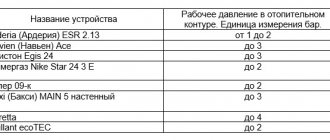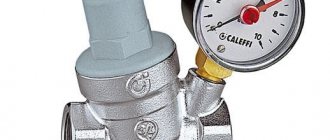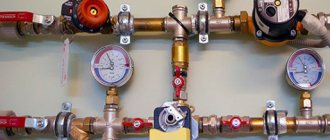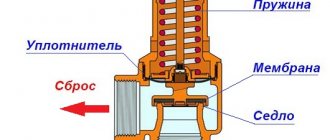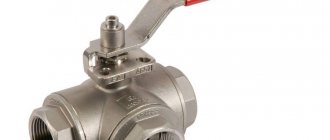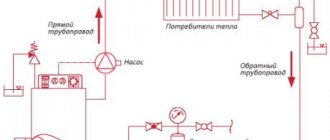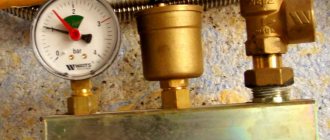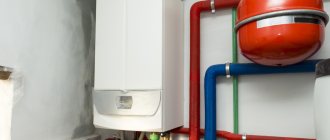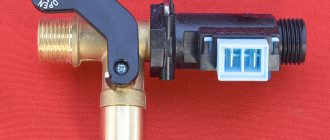The procedure for setting pressure - what it should be and how to set it
The coolant pressure in the heating system tank is an adjustable parameter.
You can perform all setup steps yourself. To do this you need:
- Make calculations and understand what pressure should be in the expansion tank. It should be made 0.2 atmospheres less than in the heating system.
- This indicator is set before placing the container by releasing air or pumping it in through a nipple. But first you need to know how to pump up the heating expansion tank correctly.
- The container is connected to the pipeline and the system is filled with water, doing it slowly, observing the pressure indicators. The liquid is pumped until the pressure levels are equal.
- Then connect the pump and continue to pump liquid until the pressure in the tank reaches the operating values, which are calculated before installing the network. As a result, a reserve volume of coolant will enter the housing.
- The system must be started at maximum temperature, and then the volume of the working medium increases by the specific increment. This ensures that water enters the device, the volume of which is equal to the capacity of the tank. As a result, the pressure reaches maximum values.
To know what the pressure should be in the expansion tank of a double-circuit boiler, you should look at the instructions for it. You can set all parameters yourself using a pressure gauge and a car compressor.
The diaphragm type tank is divided by a membrane. One of the halves is under pressure, air or nitrogen is pumped into it. You can clarify this parameter by looking at the documents for the tank. Preliminary (factory) pressure will not necessarily be optimal for circuit operation. This setting can be easily reconfigured. Manufacturers have provided for this by leaving a spool in the body of its “air” part, with which you can regulate the air pressure.
It is worth considering that all pressure gauges only show excess pressure. That is, if you need to use the concept of absolute pressure in calculations, then you always need to add one atmosphere (bar) to the pressure gauge readings.
∆P 0.2 = 0.8 0.2 = 1.0 atm (bar).
Below are the consequences of incorrectly set pressure:
- The tank is pumped. For example, the air cavity is initially set to 3 bar with a static pressure of 1.5 bar. When the pump starts, the coolant pressure will change, but not much - within 1 atm. It turns out that when the pressure gauge at the boiler shows a maximum of 2.5 bar, there is still 3 bar in the air part of the membrane tank. This setting negates the entire compensating ability of the membrane device - the air will tend to push the coolant out of the tank.
- The readings inside the expansion tank are underestimated. In this case, when filling a closed system, water or antifreeze will easily push through the membrane and fill the entire container. With each increase in temperature, and with it the pressure, the safety valve will operate. In this case, the hydraulic expansion tank also becomes useless.
Tank pressure
What creates pressure in the expansion tank? This role is taken on by compressed air, which is located in a closed tank along with excess coolant. This design makes the system as stable and reliable as possible. The documentation that comes with the equipment contains all the necessary information regarding pressure indicators.
As a rule, for most models the normal range is from 1 to 1.2 atmospheres. Moreover, this indicator is measured in the absence of coolant in the circuit. Knowing the optimal level in accordance with the documentation, you can always determine when the pressure drops in your Navien boiler.
Gas boiler baxi eco four 24
Despite the fact that the pressure in the tank should be constant, it often drops during operation of the heating system.
There are a number of reasons why blood pressure drops:
- Coolant leak. Such problems usually appear in heating systems operating on antifreeze, which can penetrate even small cracks. As a result, leaks occur. They must be eliminated before pumping the expansion tank in the heating system with air.
- Reduced pressure in the boiler. If it falls significantly, you should contact the experts. If the pressure has not dropped critically and has leveled off after starting the system, then it can be used, since such failures cannot harm it.
A very popular series among all others in the BAXI line. The 4th generation boiler with a capacity of 24 kilowatts is available in various versions: with an open and closed combustion chamber. Boilers with a closed combustion chamber and forced smoke removal are designated by the letter “F” in the name. Baxi turbocharged boilers are the most popular and are often used when organizing apartment heating, so we will consider the use of an expansion tank in the heating system using this boiler model as an example.
The volume of the built-in expansion tank of the baxi boiler is indicated in the characteristics and for the ECOFOUR series it is 6 liters. To answer the question of its necessity in a separate heating system, you need to know the total volume of this system.
Calculating it is not so difficult: the filling volume of the boiler and radiators is in their characteristics, and the filling volume of pipelines can be calculated by knowing their diameter and total length. Water, after heating by 80 degrees Celsius, will increase in volume by approximately 4-5%, therefore, the recommended volume of the expansion tank is 8% of the total volume of the heating system if filled with water and 12% if antifreeze is used as a coolant (thermal coefficient antifreeze expansion is greater).
These figures are conditional (with a margin) and when selecting the capacity of the expansion tank, you must be guided by the design calculations of a specific heating system, or the manufacturer’s recommendations.
In most cases, the built-in boiler tank is quite sufficient and the decision to use a separate additional tank is made by specialists at the design stage.
Pumping up the expansion tank should only be done when the boiler is empty!
Therefore you need to do the following:
- Turn off the heating system taps
- Drain the water from the boiler through the drain valve
- Inflate the tank to the required pressure
- Close the drain valve
- Feed the heating system through the make-up tap
- Open the heating circuit taps
The air cavity of the expansion tank is equipped with a valve for carrying out technical
service. The valve design is a regular car nipple, so the easiest way to pump the expansion tank of a baxi boiler is to use a tire pump - manual or electric car. The latter is convenient because it has a pressure gauge to control the pressure, but often the boiler is located in cabinets or niches and it is not always convenient to get to it, so it is preferable to pump it up with a hand bicycle pump, and then check the pressure with a car pressure gauge and, if necessary, bleed off excess.
Sometimes, users encounter a problem when the pressure drops when turning on hot water in the baxi boiler. This problem may just be due to insufficient pressure in the expansion tank. The fact is that when the boiler switches to the hot water preparation mode, the circulation pump pumps the liquid in a small circle, i.e.
READ MORE: Blue Alps juniper - evergreen garden decoration care
only inside the boiler itself - through a secondary plate heat exchanger. In this case, the heating circuit actually does not heat up and the coolant begins to cool, the volume decreases and in the absence of compensating pressure in the expansion tank, the pressure of the heating system may drop and the boiler will display error E10.
In such a situation, you can also consider the possibility of a breakdown of the heat exchanger itself (a gap between the plates) and water from the heating circuit entering the hot water system, but this is easy to check. To check, you need to shut off the cold water supply to the boiler and open any drain valve. If water comes out of the tap under such conditions, it is obvious that this is coolant from the heating circuit and the heat exchanger needs to be replaced.
Remember, timely maintenance of a gas boiler will help avoid such situations and increase the service life of the unit.
In addition to the pressure gauge readings, frequent discharge of water through the safety valve and blocking the operation of the device help to detect an increase in pressure in a gas boiler. Having determined high pressure, first of all, excess air is released through the Mayevsky taps and the boiler is turned off. There may be several reasons for malfunctions.
The normal upper pressure value is ensured by the system by discharging excess coolant through a safety valve into the drain
An increase in pressure in a gas boiler can be caused by damage to the partition of the secondary heat exchanger, which simultaneously serves to insulate and increase the contact area of two circuits - heating and hot water supply.
The secondary heat exchanger takes water from the heating circuit for preparing and supplying hot water in a double-circuit boiler. Damage to the partition leads to the forcing of water from the hot water circuit into the heating system, increasing the pressure in it.
The secondary heat exchanger serves to service the hot water supply system. Water for domestic hot water is heated as a result of contact with the coolant of the heating circuit. The system is protected from mixing the two circuits by a metal partition, damage to which leads to the exchange of liquids and disruption of normal pressure
Replacing the heat exchanger will solve the problem. You can carry out repairs yourself, but it is not advisable to do this, since interfering with the operation of gas equipment requires knowledge and experience in this area. In addition, repairing the boiler yourself will deprive you of the right to warranty service.
A malfunction of the automatic gas boiler or a loose pump impeller, which sucks in air, also increases the pressure in the gas boiler. Equipment malfunctions that lead to disturbances in normal pressure may be the result of a manufacturing defect, a breakdown of the control board, or an incorrectly configured system. Only a qualified technician can fix this kind of problem.
Common reasons why the pressure in a gas heating boiler drops are:
- Coolant leak. Damage to the heating line leads to a loss of tightness, loss of heating water and a decrease in pressure.
- Cracks in the heat exchanger. Leaks in the boiler itself will not only lead to a decrease in pressure, but can also provoke more serious equipment breakdowns and damage electronics.
- Rupture of the membrane in the expansion tank. Through damage to the rubber partition, liquid enters the air compartment and the pressure in the circuit decreases.
To determine the location of the leak in the system, it is fed to normal pressure and the circulation pump is stopped. Step by step, it is necessary to inspect the highway, identify the problem area and troubleshoot.
How to measure and adjust the pressure in the expansion tank
H2_2
The pressure in the heating system is controlled by pressure gauges, but the tank itself does not have a fitting for installing this device. However, there is a nipple in which a spool is mounted for pumping or releasing air. It is located on the side opposite the coolant supply. The nipple, in fact, is an analogue of a car pump, so to check this parameter or adjust it, you can use an ordinary car pump with a built-in pressure gauge.
1 Bar = 1 atm = 100,000 Pa = 0.1 MPa
Measuring pressure with a car pressure gauge:
- You need to turn off the boiler and wait 5-10 minutes until the system circulation completely stops;
- Close the shut-off valves in the area where the hydraulic tank is located. Drain the water through the drain fitting. If the membrane tank is built into the boiler, then the supply and return of the coolant are shut off;
- Unscrew the nipple cap and connect the pump to it;
- Pump air to 1.5 atm and wait until the remaining coolant flows out of the membrane tank, then release the air again;
- Shut off the shut-off valves and use a pump to bring the pressure in the membrane tank to the recommended pressure in the section above. If the tank is over-pumped, you need to bleed off the excess through the spool;
- Remove the pump, screw the cap onto the nipple and close the drain fitting. Open the shut-off valve and add water to the heating system through the make-up tap;
- It is easy to check whether the air pressure is adjusted correctly or not. When the boiler reaches operating parameters, the pressure gauge needle does not jump, the pressure builds up smoothly without jumps.
What should be the pressure in the heating system?
When organizing heating systems, various options can be used, but recently closed systems have become more popular, in which the coolant moves due to the operation of a circulation pump. A gas burner heats water (or antifreeze) in a primary heat exchanger, and a pump pumps it through a radiator system, transferring heat to the premises.
The diagram shows a system in which the boiler acts exclusively as a heater. In household wall-mounted boilers ECOFOUR, the expansion tank and circulation pump are already built-in, which is why such boilers are convenient to use in small apartments.
If you open the instructions, it indicates the pressure in the expansion tank is 0.5 bar, but this is the minimum value, correctly - the pressure should be about 20% less than the pressure in the heating circuit at room coolant temperature.
Based on the fact that for most systems the recommended filling pressure is in the range of 1.2 to 1.5 bar, we obtain the required pressure in the air cavity of the expansion tank equal to 0.8-1 bar. Experts usually recommend setting the pressure in the BAXI expansion tank to 1 bar.
Heating systems can be divided into two types - closed and open. When open, the pressure regulation function is performed by a leaky expansion tank.
The container is installed at the top point of the heating circuit and serves to hold the coolant expanding when heated, to remove air, and also acts as a safety valve. The operating pressure in such a system depends mainly on the temperature of the heating water.
Most often, when organizing heating in houses and apartments, closed heating systems are used. They are more effective and safe, but require constant pressure monitoring.
It is very important to monitor the pressure and temperature of the coolant, and respond to any signs that are not typical for the normal operation of the heating system - knocking, frequent discharge of hot water through the safety valve, cold sections of the circuit
The pressure in a closed-type circuit arises due to forced circulation carried out using a pump. Pressure deviations from the norm can lead to equipment failure.
The nominal pressure in gas boilers of different models may vary; it is determined by the technical characteristics of the equipment
When designing a heating system, the pressure is calculated taking into account the height of the water column, the length of the system, the characteristics of the connected equipment, and the cross-section of the pipes.
READ MORE: Norms of air humidity in an apartment and ways to measure it
To adjust the working pressure, you need to focus on the following parameters:
- Technical characteristics of a gas boiler. The manufacturer indicates the capabilities of the equipment and its settings in the instructions.
- Coolant temperature. The higher the temperature, the greater the pressure in the circuit; as it decreases, it decreases. Therefore, setting and measuring the pressure in the gas boiler and heating circuit must be carried out before and after heating the coolant.
- Volume of the circuit and expansion tank. The size of the accumulator has a direct impact on the pressure in the heating circuit and the range of its fluctuation.
- Acceptable pressure indicators for the least “weak” element of the system. The pressure in the system should not exceed the permissible values for each of its elements. For example, polypropylene pipes, which on average are designed for a pressure of 25 bar at room coolant temperature, can withstand an increase in pressure only up to 7-9 bar at a temperature of 90 °C.
The minimum pressure in the circuit can be 0.5-0.8 bar, the exact standard values are indicated in the instructions, in accordance with them the pressure sensor is adjusted to the required value. If the pressure in the heating system drops below 0.5 bar, an emergency situation occurs, in which the gas boiler may stop or be damaged.
The highest pressure value in the system is up to 3, less often up to 4 bar. For a five-story building, pressure values are adjusted to 5 bar, for a ten-story building to 7 bar. When making settings, it is necessary to adhere to the difference in pressure between the outgoing and return pipes - it should be 0.3-0.5 bar. After starting the heating, check if this is the case.
Increased pressure in the Navien boiler
An increase in pressure above the operating pressure leads to the constant activation of boiler locks and the release of excess water through the safety valve.
In this mode of operation, all elements of the system experience a load that can lead to serious damage to the circuit, so it is necessary to quickly establish the reason why the pressure in the system increases. You can determine that the pressure in the circuit is increasing using pressure gauges. They always show excess pressure - the difference between the pressure in the system and atmospheric pressure. Closed autonomous heating systems operate at 1.5 - 2.5 bar.
In open heating systems, the hydrostatic pressure is always the same and depends on the difference in levels.
If we take the boiler as the zero mark, and the expansion tank as the highest point, which is, for example, at a height of 10 m, then it is considered that the boiler operates at an excess pressure of 1 atm (10 meters of water column = 1 atm).
Reasons for increased pressure in the heating circuit due to problems with the expansion tank:
- Small expansion tank volume. When heated to 85-90 °C, water adds about 4% in volume. If a small tank is selected, the coolant expands when heated and fills the container. There is a complete release of air through the valve. With further heating, the tank can no longer compensate for the thermal increase in the volume of water, as a result, the pressure in the system rises. The volume of the expansion tank must be at least 10% of the total coolant volume in the circuit if a gas boiler is installed, and at least 20% if the boiler is solid fuel. The volume of the tank can be taken approximately according to the boiler power: for 1 kW there are approximately 15 liters of water. But it is better to calculate the volume of a separate circuit (based on heating surfaces);
- Damage to the rubber membrane of the tank. In this case, the water will completely fill the container, and the pressure gauge will show a drop in pressure in the system. But, if you open the make-up valve and add water, then when the coolant heats up, the pressure in the heating circuit will become significantly higher than the operating one. To solve the problem, you will need to replace the tank if the membrane is diaphragm type, or replace the membrane if it is balloon type;
- The pressure in the expansion tank is too high or too low. Malfunctions in the expansion tank are one of the main reasons for increased pressure in a closed system. You can check the pressure and pump it up if necessary using an ordinary car pump. Before checking, you need to drain the water from the heating system - the needle on the system pressure gauge should be at zero. If there are shut-off valves and a drain on the water pipeline to the expansion tank, then it is enough to drain the water only from the tank. Then air is released through the nipple, which is located on the side opposite to the water supply. If the boiler operates at a pressure of 2 bar, then the pressure gauge on the pump should show 1.6 bar. You need to open the water shut-off valve and add the volume of water drained from the expansion tank through the make-up tap. This adjustment method works for both tanks with bottom and top water supply;
- The tank is located immediately after the circulation pump. This leads to the fact that the pressure rises sharply, and almost immediately it is released, and pressure surges are observed. This situation can provoke hydraulic shocks in the circuit. To solve this problem in a closed heating circuit, the expansion tank is installed on the return pipe - in a laminar flow zone with a minimum coolant temperature. The pump crashes into the return line after the tank, in front of the boiler.
Reasons for increased pressure due to the formation of an air lock in a closed system:
- Quick filling of the system with water at start-up;
- The contour is filled from the top point;
- After repairing the heating radiators, they forgot to bleed air through the Mayevsky taps;
- Malfunctions of automatic air vents and Mayevsky taps;
- A loose circulation pump impeller, through which air can be sucked in.
The water circuit must be filled from the bottom point with the air bleed valves open. You need to fill it slowly until water flows from the air vent at the highest point of the circuit.
Before filling the circuit, you can coat all air-bleeding elements with soap foam to check their functionality. If the pump is sucking in air, there will probably be a leak underneath it.
In an open system, with proper design of the slopes, all air is removed through the expansion tank. Air pockets can only occur if the system is not properly filled with water during startup or after radiator repairs.
If such problems arise, the air can be easily vented through Mayevsky taps on the radiators. If it is not possible to reduce the pressure, then it may be necessary to completely drain the system and restart it.
An increase in pressure in the heating system is also possible due to the fact that:
- The shut-off valve is partially or completely blocked. As a result, the water supply pressure increases sharply and the boiler is blocked. It is necessary to open shut-off taps and valves, check the heating fittings for leaks;
- If a mechanical mud filter is installed, its mesh may become clogged with particles of rust, slag or sand. As a result, pressure rises in the boiler-filter section. Washing the filters will help relieve the coolant pressure. The simplest corner filter needs to be washed at least 3-4 times a year. Wash and magnetic filters are more expensive, but such devices purify water better and require cleaning only once a year;
- The make-up water tap is leaking or not “holding”. The pressure in the water supply network is in the range of 2.5 - 3.5 bar, that is, water will flow into the heating system, where the pressure is lower. This will inevitably lead to an increase in the volume of coolant. To solve the problems, you need to turn off or replace the make-up water valve. Most often, rubber gaskets become unusable and require replacement. As a temporary solution to the problem until the damaged parts are replaced, you can reset the indicators by completely shutting off the water supply to the double-circuit boiler;
- Malfunction of the boiler automation, failure of the thermostat or controllers. It is not always possible to determine why this happens. The reason may be manufacturing defects, the use of low-quality materials in the manufacture of the control board, incorrect installation, etc. You can fix the problem yourself if you know the error code and have the technical data sheet of the device. If the technical data sheet does not contain an error code and a method for eliminating it, you cannot do without a service department.
Source: https://sovterror.ru/povyshennoe-davlenie-v-kotle-naven/
Design and location of the BAXI expansion tank
The baxi eco four 24 expansion tank is a red round tank located on the back wall of the boiler. The built-in expansion tank baxi with a volume of 6 liters is divided into two parts by an elastic membrane, one part is connected to the heating system, the second is pumped with air. Therefore, when the heating system heats up, the increasing volume of liquid overcomes the resistance of the membrane and fills the vacated volume of the tank, and when it cools, the membrane tends to move to its original position and pushes the liquid back into the heating system. Thus, the pressure in the heating system remains practically unchanged during operation.
Increasing pressure in the heating circuit
System pressure is monitored using instruments that measure and display circuit pressure using a digital or mechanical dial. The sensors are installed by the manufacturer at the boiler outlet.
During the installation of the system, pressure gauges are also installed near the collectors, which distribute the coolant to various parts or floors of the building.
A safety group for boilers in the heating system helps control the temperature, pressure in the circuit, protects equipment from destruction by removing excess pressure outside
Additional pressure control is required when using boilers to heat water in underfloor heating systems. A drop or increase in pressure can be observed differently in different parts of the heating system.
A closed loop allows you to increase the pressure in the system, which increases its safety, since at higher pressure the boiling point of the liquid increases
When starting a gas boiler, check the pressure gauge while the heating water is still cold - the pressure should not be lower than the minimum value indicated by the red adjustable pressure gauge needle. The setup is carried out by a representative of the company with which a contract for service and gas supply has been concluded.
The initial setting is carried out when heating is started for the first time. In the future, the pressure is checked every week, and if necessary, the system is topped up with water. Make-up is carried out at a coolant temperature below 40 °C.
What to do if the pressure in the heating system rises excessively?
First of all, you need to establish the cause, and there may be several of them:
- Incorrect filling of the contour, its airiness. Due to the rapid filling of the heating line, air pockets may form in it. To avoid this phenomenon, when starting the heating, it must be filled slowly.
- The circuit temperature is too high. Any increase in temperature and coolant leads to its expansion and increased pressure in the system. It is necessary to prevent too high an increase in order to protect heating equipment from critical loads.
- Stopping the flow of coolant. The reason may be blocked shut-off valves, clogged mud filter, or air locks.
To identify the problem area, you need to examine the entire contour step by step.
The filter must be checked and cleaned immediately after the boiler is started for the first time, and then again a week later.
Next, scheduled checks and cleanings are carried out once a month or season, depending on the degree of contamination of the coolant. Leaks can be caused by breakdown of the make-up valve - wear of the valve gasket, mechanical damage to parts, and scale trapped between the seat and the gasket. If the tap is leaking, then excess water flowing from the water supply system into the heating main increases the pressure in it, because the pressure in the cold water pipeline is always higher. It is necessary to tighten the tap or replace it if it is faulty.
Air locks are a common cause of problems in the heating system. These can be caused by malfunctions of the gas boiler itself, problems in the circuit or incorrect starting of the heating.
Restarting the system will help troubleshoot problems - slowly filling it with coolant, starting from the lowest point, until water flows from the top point of the circuit. All air bleed valves must be open. Airing the system can lead to both an increase and a decrease in pressure.
Why does pressure increase in closed boilers?
The main reasons why blood pressure rises are as follows:
- the heating circuit is filled from the top;
- quick filling with coolant during startup;
- a loose pump fan through which air passes;
- air vent failure;
- After the system was repaired, the air was not vented.
The heating circuit must be filled from the bottom, and the safety valves must be open. It is necessary to fill gradually until liquid begins to drain from the safety taps. Before you start filling the heating circuit, all air bleed parts must be treated with a soap solution, this way you can check their normal operation.
Important! If the injection pump is leaking air, then it is the cause of the increased pressure.
Malfunctions of expansion tanks
Checking the pressure of the expansion tank is included in the list of annual maintenance procedures and if it is followed there will be no problems, but if neglected it can give the owner unpleasant surprises:
- the pressure in the air chamber gradually decreases and with each refill of the boiler the tank fills more and more with water and gradually ceases to perform its function. In this case, the membrane is so pressed against the wall of the air part of the tank that it can be damaged by the valve spool and the tank will have to be replaced.
- The heating circuit pressure is at the permissible limit, the expansion tank has not been serviced - there is no pressure in it. When the heating system cools down, the volume of liquid decreases, the pressure drop is not compensated for by anything - the boiler stops due to an emergency. This situation can arise, for example, when the boiler operates for a long time in DHW mode or when there is a power outage.
- the owner of the boiler often has to top up the boiler for no apparent reason, for example, while hot water is being used - the pressure on the pressure gauge drops and the boiler stops by mistake - the owner tops up. Since thermal expansion is not compensated by anything, with further heating of the coolant, excess pressure is released through the safety valve. Some users set the reset and simply do not notice this situation. Frequently refilling the boiler with untreated water is detrimental to the heat exchanger!
READ MORE: Simple ways to transform your kitchen: main design techniques
How to control the system and work with it?
Expansion tanks are tightly closed vessels, which are divided into two fragments using rubber membranes. This is not simple rubber, since it must withstand significant heat while remaining elastic and without losing strength.
That is, by the time it is put into operation, the tank will be completely empty, and its entire volume can be used to correct the thermal expansion of water or antifreeze. If the gas boiler sensor detects that the pressure in the heating system has dropped to 0.7 bar or less, it gives a command to turn off the heater. And the average value that ensures normal operation is 1.2 bar. Since moving from a non-equilibrium position to an equilibrium one, the membrane can increase the pressure further, its initial level for an empty tank is taken to be 0.3 bar (on average) higher than the standard for a heating system.
Conclusion: with a closed heating circuit with a gas boiler, the pressure should be from 0.8 to 1 bar; the parameters of any system deviating from the standards are calculated individually, taking into account:
- expected volume of water or antifreeze;
- Tank efficiency;
- its required value;
- initial pressure at start-up.
Tanks on Baxi double-circuit boilers, as follows from the instructions, must operate at a pressure of 0.5 bar. However, in reality this figure is minimal, and the same pressure of 0.8 - 1 bar allows you to guarantee the normal functioning of the device. The built-in expander with a capacity of 6 liters works stably with heating systems with a capacity of 75 liters (on water). Or 50 l (with antifreeze).
Whether it is necessary to use an additional expansion tank, or whether standard equipment is enough, is decided only by specialists at the time of preparation of the project.
It is very important to check the actual pressure in the expansion tanks. Hand-held pressure gauges are almost always used for this purpose, since most air chambers are equipped with standard nipples, like car or bicycle tires. A problem may arise if the boiler is wall-mounted. Compensating devices are most often located on its rear wall, and it can be difficult to use them. The solution is to use a compact mobile pressure gauge.
As soon as a downward deviation is detected, the air should be inflated correctly. Leaving everything as it is, you may encounter emergency shutdowns of the boiler. It is difficult to even say whether this outcome or the release of excess fluid is worse. Each manufacturer of gas boilers advises consumers to measure the pressure in the tank annually. There will be no harm, of course, if you do this twice as often.
It must be remembered that pumping is carried out only when the tank is completely empty; to do this, drain the water from the boiler. The easiest way is to use a bicycle pump while monitoring the result through a hand-held pressure gauge.
The sequence of actions is as follows:
- the heating system taps are turned on;
- water drains from the boiler;
- the tank is inflated to the required pressure;
- the drain valve is closed;
- the heating circuit is saturated to the required level through the provided tap;
- The taps connecting the tank to the heating open.
Problems with the expansion tank that affect the pressure in the heating circuit are very common. Incorrectly calculated volume of the expansion tank is one of the most characteristic prerequisites.
Malfunctions can result from improper installation, low or high pressure in the air chamber of the tank, a damaged membrane - each of the reasons can lead to disruption of coolant circulation in the system.
If a small volume tank is installed in the heating system, it cannot compensate for the expansion of heating water when heated. At a temperature of 85-95 °C, water expands by approximately 4% and its excess volume exits through the safety relief valve.
In order for the expanzomat to fully perform its compensatory function, its capacity for systems with a gas boiler must be at least 10 percent of the total volume of water in the circuit.
If you install a tank with a larger volume than normal, the pressure fluctuations will be even smaller. Reducing pressure differences has a positive effect on the operation of the system and the service life of heating equipment
Damage to the tank membrane leads to water completely filling its volume and the pressure in the circuit drops. If you fill the volume of the circuit by opening the make-up valve, this will create a new problem - when the coolant heats up, there will be no room for it to expand and the pressure in the system will increase more than normal. The situation can only be corrected by replacing the rubber partition.
The tank should only be installed on the return pipe, in front of the heating boiler. This way the tank will have minimal impact on the operation of the circulation pump, which is installed after the gas boiler. In addition, here the water temperature is lower and the negative impact on the pressure in the system and on the tank membrane will be less.
The pressure formed in the air chamber of the expansion chamber can also lead to an increase or decrease in pressure inside the heating system. You can check and pump up the air in the tank only if there is no coolant in the tank.
To do this, you need to shut off access to the common circuit using shut-off valves and drain the water through the drain. Then the pressure in the air chamber is measured and inflated/lowered to the required values.
You can check the pressure in the expansion tank using a car pressure gauge, and pump it up using a car pump.
To set the pressure of the expansion tank in the air chamber, it must be 0.5 bar higher than the expected maximum pressure in the system. After the pressure in the equalizing part of the tank is adjusted, fill the circuit with cold water to the expected pressure value.
Then the air is released from the air chamber until the pressure in the heating circuit and the tank begins to decrease simultaneously - here it is necessary to simultaneously monitor the pressure in the system and in the expansion tank.
In this phase, changes in indicators are little noticeable, so you must be prepared to immediately stop bleeding air from the expansion tank as soon as a simultaneous decrease is detected.
All tanks are similar in design. They have a metal body, divided from the inside into two rolled compartments. The tank has a nipple on one side, and on the other there is a neck designed for connection to pipes.
There is a diaphragm inside the body. When the container is empty, it fills most of it, and the remaining space is occupied by air. During the operation of the network, the coolant heats up, its volume increases, and the excess penetrates into the cavity between the diaphragm and the housing.
After the temperature drops, the working medium decreases in volume, and the previously pumped air squeezes it back into the system.
Pressure increase due to expansion tank
What is the reason and what can be done if the pressure gauge shows high pressure?
The problem may lie in the expansion tank.
- Membrane damage. When heated to the maximum set temperature in the heating system, the liquid increases in volume by approximately 4%. This excess volume enters the expansion device, compensating for the pressure in the system.
If the membrane is damaged, the liquid will completely fill the volume and initially the pressure in the system will drop. When you open the make-up tap and add water to the system as the temperature increases, the pressure will become higher than rated.
How to determine that the membrane is damaged - when pumping air, the pressure drops, excess liquid comes out through the hoses that connect to the system. A new tank is needed.
- Too small a volume of the expansion device causes the pressure to rise quickly as the temperature rises. The size of the compensation tank depends on the power of the heat generator, provided that standard radiators are connected. But, if you use pipes instead of radiators, the amount of coolant will be greater, in this case the pressure will be maintained at a constantly high level.
- The discrepancy between the pressure in the compensation tank and the nominal one is also the reason why the pressure increased. You can pump it up using a car pump with a pressure gauge, after draining the liquid from the boiler and turning off the supply and return taps.
Pump the pump until you see that the water is not flowing. Then you need to bleed the air and pump it up again to the value specified in the boiler manual. Unfortunately, not all manufacturers indicate the pressure of the expansion tank of their products in the instructions; for example, it is not indicated in the instructions for the Immergaz heat generator.
Water hammer causes high pressure in a gas boiler, what to do in this case? In some double-circuit boilers, the compensation tank is located immediately after the circulation pump; when it is turned on, the pressure rises sharply, then also drops sharply.
How can you reduce the influence of the pump and remove excess pressure - the expansion tank is mounted on the return pipe, and the pump is installed in series after the tank, in front of the boiler.
The working pressure of the compensation tank of some 24 kW models is shown in the table.
